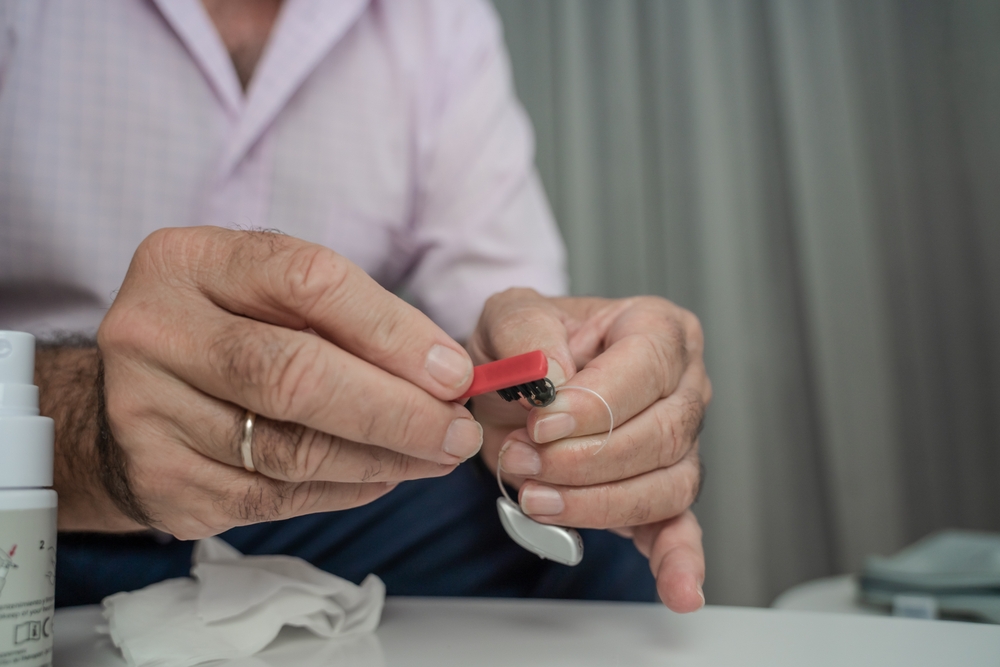
Once you’ve adapted to life with your hearing aid, it becomes an indispensable part of your day-to-day routine. The prospect of a breakdown can be distressing, as it presents not just a disruption to daily life, but also a significant monetary burden in the form of repair or replacement expenses.
How to properly care for your hearing aid
Comprehending what can damage your hearing aid and learning how to maintain it correctly will help you maintain its performance and ensure it continues to enhance your quality of life.
Practical care of batteries
The performance of your hearing aid depends greatly on its battery. Hence, it is essential to select the right batteries for your device. Consult with your hearing specialist to figure out the best battery type for your model.
It is just as important to handle the batteries with care. Oils, dirt, and moisture from your hands can contaminate the batteries, leading to potential damage.
Before switching out the battery, make sure your hands are clean and totally dry to prevent any moisture from entering the device.
Follow the manufacturer’s instructions diligently, especially concerning battery care. Power off your hearing aid when it’s not in use to protect battery life and store it in a secure , dry place. Knowing the typical lifespan of a battery can also be really handy.
Mark on your calendar when you replace the battery, so you can prepare for when it needs to be switched out. To avoid being caught without power, always carry a spare battery with you, especially when you’re away from home.
Prevent moisture damage
As electronic technology, hearing aids are vulnerable to moisture. Even minor exposure can result in damage or a complete malfunction of the device. To protect your hearing aid, think about investing in a dehumidifier developed specifically for hearing aids. This device provides a safe and dry environment for your hearing aid when not in use, safeguarding it from damage caused by excessive moisture.
To protect your hearing aid from moisture damage, it’s a smart idea to take it out before taking part in activities that make you perspire heavily. However, consult your hearing specialist first, as removing your hearing aid during exercise, especially outdoors, may pose safety risks by reducing your ability to hear environmental sounds like traffic or alarms. If necessary, go with indoor exercise where it’s safer to be without your hearing aid, and always remember to take out your device before showering or swimming.
Additionally, avoid using hairspray, spray deodorants, and other aerosol products while wearing your hearing aid. Prolonged exposure to these products can cause harm to the device, as the moisture and chemicals they contain can accumulate and result in lasting deterioration over time. Apply these products before mounting your hearing aid to minimize exposure.
Prevent excessive ear wax accumulation
Though earwax plays a protective role by keeping dust, insects, and other foreign particles out of your ears, it can present a challenge for your hearing aid. The buildup of earwax in the device can result in it not working properly. To manage this, have your ears checked out by your hearing specialist or physician to assess the level of earwax buildup and create an appropriate cleaning routine for both your ears and your hearing aid.
Cleaning your ears safely is vital– never insert any objects into your ear canal. As opposed to that, let warm water go into your ears while you shower. This can help in losening up and removing some of the earwax. Regular professional ear cleaning is also advisable. While this may seem inconvenient, it’s significantly less troublesome than dealing with a malfunctioning hearing aid caused by excessive earwax.
To properly clean your hearing aid, carefully adhere to the guidelines provided by the manufacturer.
Different types of hearing aids may require different cleaning techniques, and using the wrong method could cause harm to your device. If you’re unsure about the proper cleaning method, consult your hearing specialist or hearing aid provider to ensure you’re taking the correct steps to protect your device from earwax damage.
Basic steps for lasting reliability
After you’ve grown accustomed to wearing your hearing aids, they become an integral part of your life, making it hard to imagine managing without having them. By using a few basic safety measures, you can prevent damage and ensure your hearing aids continue to be reliable for years to come. Regular maintenance, proper storage, and careful handling are key to keeping your hearing aids in optimum condition, allowing you to continue enjoying the improved quality of life they provide.
Make an appointment if you’re experiencing issues with your hearing aid or need to schedule a regular maintenance appointment.
